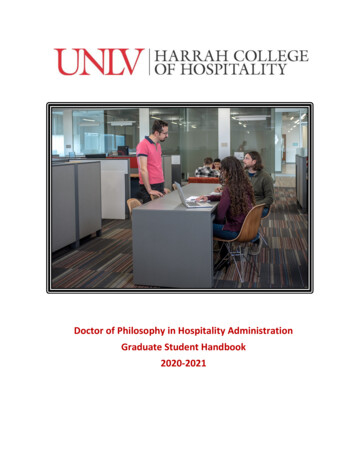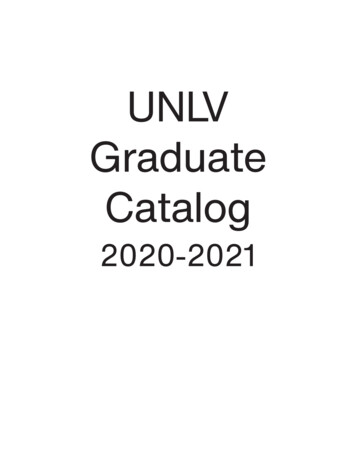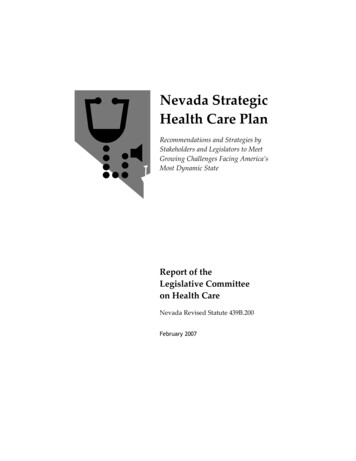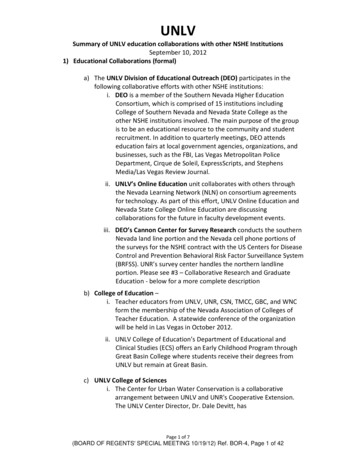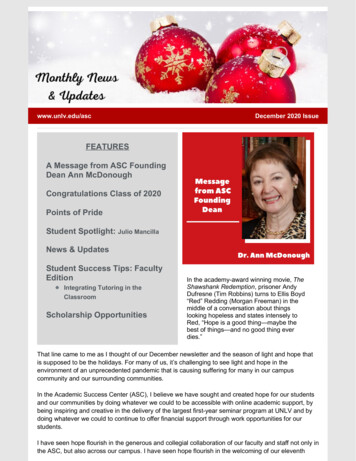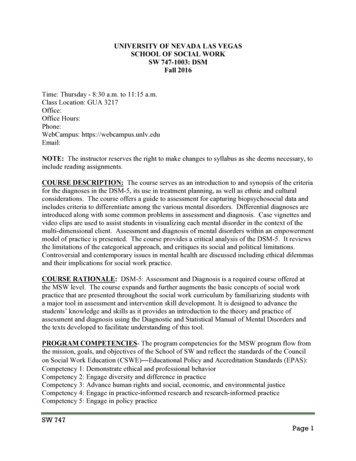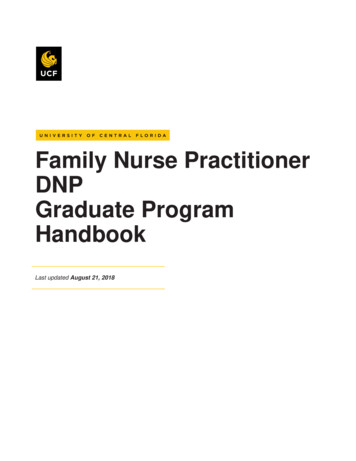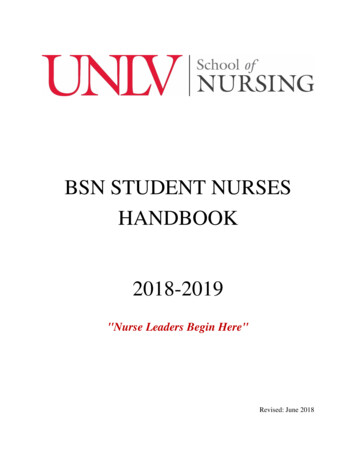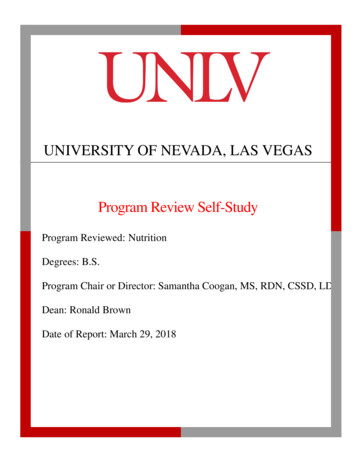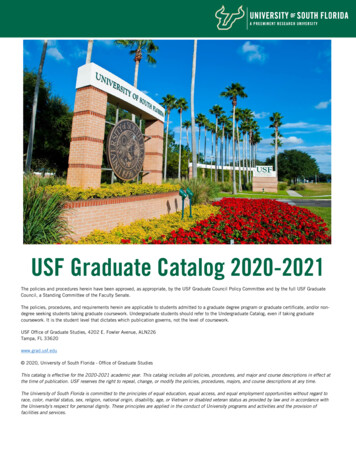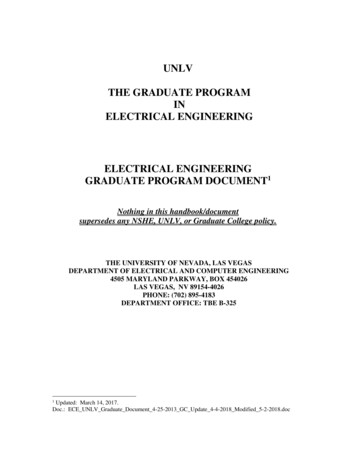
Transcription
UNLVTHE GRADUATE PROGRAMINELECTRICAL ENGINEERINGELECTRICAL ENGINEERINGGRADUATE PROGRAM DOCUMENT1Nothing in this handbook/documentsupersedes any NSHE, UNLV, or Graduate College policy.THE UNIVERSITY OF NEVADA, LAS VEGASDEPARTMENT OF ELECTRICAL AND COMPUTER ENGINEERING4505 MARYLAND PARKWAY, BOX 454026LAS VEGAS, NV 89154-4026PHONE: (702) 895-4183DEPARTMENT OFFICE: TBE B-3251Updated: March 14, 2017.Doc.: ECE UNLV Graduate Document 4-25-2013 GC Update 4-4-2018 Modified 5-2-2018.doc
Table of Contents1. Department of Electrical and Computer Engineering-General Information 21.1Department Message 21.2Purpose 21.3The Faculty 21.4Annual Review Procedures 51.5Discipline Resources 51.5.11.5.21.5.31.5.4Department Facilities 5Useful ECE Department and Graduate College Document Links 6Typical Degree Timeline 7University Resources 81.6 University Policies and Procedures 92. Overall and Specific Degree Program Objectives, Outcomes, and Assessments 112.1Overall Electrical Engineering Graduate Program Objectives 112.2MSEE Program-Course Only Option 112.3MSEE Program-Thesis Option 112.4Ph.D. Program 123. Department Regulations 143.1Advisors 143.2Transfer Credit 143.3Non-degree Seeking Student Credits 143.4Gradute Teaching Assistantship (GTA) 143.5Academic Integrity 153.6Informal Courses 163.7Waivers 173.8Counting 600 Level Classes in a Master or Ph.D. Degree Program 173.9Provisional and Conditional Status 183.10 Admission Application Deadlines 184. Master of Science Program Options in Electrical Engineering 194.14.1.14.1.24.1.34.24.2.14.3Admission Requirements 19General Admission Requirements 19Admission Requirements for the Fast Track M.S.E.E. Program Option 21Additional Admission Requirements for International Applicants 21M.S.E.E. Degree Requirements 21Time Limits 24No Risk Pass/Fail Ph.D. Pre-Qualifying Exams 24
Electrical Engineering Graduate Program DocumentRevised: April 25, 2013Modified: May 2, 20185. Ph.D. Program Options in Electrical Engineering 255.15.1.15.1.2Admission Requirements 25General Admission Requirements 26Additional Admission Requirements for International Applicants 285.2Ph.D. Degree Requirements 285.3Qualifying Exam 315.3.15.45.4.1Appeals 32Comprehensive Exam 33Appeals 335.5Preliminary Exam 345.6Final Exam 345.7Time Limits 355.8Ph.D. Major and Minor Fields 355.9Subfield Listings for MSEE and PhD Programs 365.9.15.9.2Recommended Reading for Qualifying Exam 36MSEE and PhD Field/Area Disciplines 376. Electrical Engineering Graduate Courses 46Program Flow Charts and Road Maps are at the End of the DocumentNothing in this handbook/documentsupersedes any NSHE, UNLV, or Graduate College policy.Handbook Information Changes (Based On 4-4-2018 Version)Last revised5-2-2018Revised byRAS Jr.Changes summaryNew Grad. Coord and Department Chair page 21
Electrical Engineering Graduate Program DocumentRevised: April 25, 2013Modified: May 2, 20181.Department of Electrical and Computer Engineering – GeneralInformation1.1Department MessageElectrical engineering is the basic and applied research of scientific and mathematical principles to investigate,invent, develop, design, manufacture, and control of machines, processes, phenomena, and/or systems. The work ofelectrical engineers has had and continues to have a direct and vital impact on people’s lives in the fields ofenvironment, energy, defense, homeland security, data security, medicine, space exploration, safety,communication, biology and extending to all types of industrial and manufacturing issues. For example, electricalengineers have been responsible for the creation of electric power and signals at all frequencies and pulse repetitionrates, modern electronics, computers, electronic communication systems, modern flight controllers, automatedmanufacturing, medical diagnostic tools. An electrical engineering education continues to provide opportunities forsolving problems of great social significance and for augmenting the quality of life. The Department of Electricaland Computer Engineering at UNLV has excellent facilities for graduate education and research in electricalengineering. In addition, the Electrical and Computer Engineering faculty is experienced and knowledgeable inmany of the electrical engineering disciplines, including communications, computer engineering, control systemtheory, electromagnetics and optics, electronics, power systems, signal processing, and solid state devices. AtUNLV, students have the opportunity to interact effectively with faculty and personnel so that programs andresearch theses and dissertations can be tailored to their interests.1.2PurposeThe purpose of this handbook (ECE Graduate Document) is to provide recently updated program specificinformation that may not be found in the UNLV Graduate Catalog. Students are responsible for understanding andfollowing the policies and procedures delineated in this document and the UNLV Graduate Catalog, as well as theNSHE Code, UNLV Bylaws, and the UNLV Student Conduct Code. Questions about policies should be directed tothe Graduate College: valarie.burke@unlv.edu or kendall.hartley@unlv.edu. Nothing in this handbook/documentsupersedes any NSHE, UNLV, or Graduate College policy.1.3The FacultyA current listing of the graduate faculty can be found in the UNLV Graduate Catalog. Faculty must hold eitherassociate or full graduate faculty status to be involved in graduate education at UNLV. For up to date informationregarding graduate faculty status in your department, visit the Graduate Faculty status web page.Chair:Biswajit DasPh.D. Purdue University (1989)Office: TBE 324; Phone: (702) 895-2530Email: dasb@unlv.nevada.eduGraduate Coordinator:Henry SelvarajOffice: TBE B336: Phone: (702) 895-4184Email: henry.selvaraj@unlv.eduElectrical and Computer Engineering Main Office:Department SecretaryOffice: TBE B325Address: Box 545026, 4505 S Maryland Parkway, Las Vegas, Nevada 89154-4026Phone: (702) 895-41832
Electrical Engineering Graduate Program DocumentRevised: April 25, 2013Modified: May 2, 2018Fax: (702) 895-4075Professors:Yahia BaghzouzPh.D. Louisiana State University (1987)Office: SEB 2167; Phone: (702) 895-0887Email: yahia.baghzouz@unlv.eduResearch Interests: Power system harmonics/power quality; computer-aided analysis of electric power systems;solar photovoltaic systems; renewable energy integration with the utility grid.R. Jacob BakerPh.D. University of Nevada, Reno (1993)Office: TBE B328; Phone: (702) 895-4152Email: r.jacob.baker@unlv.eduResearch Interests: Integrated circuit designBiswajit DasPh.D. Purdue University (1989)Office: TBE 324; Phone: (702) 895-2530Email: dasb@unlv.nevada.eduResearch Interests: Nanotechnology, Nanoscale device fabrication and characterization, Biomedical applications ofnanotechnology, Sensors and sensor networks, RF Circuit Design.Yingtao JiangPh.D. University of Texas at Dallas (2001)Office: SEB 4247; Phone: (702) 895-2533Email: yingtao.jiang@unlv.eduResearch Interests: Algorithms, VLSI architectures, and circuit level techniques for the design of DSP, networkingand telecommunications systems; computer architectures; computer aided designs; biomedical signal processing,instrumentation, and medical informatics; BioMEMS/BioNEMS; wireless communications and security.Pushkin KachrooPh.D. University of California at Berkeley (1993)Office: SEB 3218; Phone: (702) 895-4926Email: pushkin@unlv.eduResearch Interests: Nonlinear and hybrid control systems, intelligent transportation systems, mechatronics, robotics,distributed parameter systems, differential geometric methods, feedback control in e-marketing, and education andlearning, bio-dynamics and control, nano-bio transport control and robotics.Shahram LatifiPh.D. Louisiana State University (1989)Office: TBE B316; Phone: (702) 895-4016Email: shahram.latifi@unlv.eduResearch Interests: Computer networks, parallel processing, fault-tolerant computing, data compression.Emma RegentovaPh.D. Polytechnic of Yerevan (now, State Engineering University of Armenia) (1989)Office: TBE B320; Phone: (702) 895-3187Email: emma.regentova@unlv.eduResearch Interests: Classical and applied image processing, image analysis, coding and compression, patternrecognition; Advanced Computer Architectures; Computer Networks.Robert A. Schill, Jr.3
Electrical Engineering Graduate Program DocumentRevised: April 25, 2013Modified: May 2, 2018Ph.D. University of Wisconsin-Madison (1986)Office: TBE B334; Phone: (702) 895-1526Email: Robert.Schill@unlv.eduResearch Interests: Charged particle beams; microwave theory; fiber, traditional and modern optics; plasmaphysics; electromagnetic fields and material interactions; linear and nonlinear waves; pulsed power; biomedical andenvironmental applications of electromagnetics and pulse power.Henry SelvarajPh.D. Warsaw University of Technology (1994)Office: TBE B336: Phone: (702) 895-4184Email: henry.selvaraj@unlv.eduResearch Interests: Digital circuit design; programmable logic devices; logic synthesis; application of logicsynthesis techniques in machine learning; data compression and data mining, functional decomposition; PLAs; andFPGAs; multiple valued functions and applications; artificial intelligence and multimedia; microprocessorarchitecture; and DSP.Sahjendra SinghPh.D. The Johns Hopkins University (1972)Office: TBE B326; Phone: (702) 895-3417Email: sajendra.singh@unlv.eduResearch Interests: Systems and Control Theory. Robotics. Applications to Aerospace Stability and Control. FluidFlow Control.Peter StubberudPh.D. University of California Los Angeles (1990)Office: TBE B324; Phone: (702) 895-0869Email: peter.stubberud@unlv.eduResearch Interests: Digital Signal Processing, multidimensional digital signal processing, adaptive signalprocessing, neural networks, mixed signal VLSI design, data converters.Ke-Xun SunPh.D. Massachusetts Institute of Technology (Physics 1993)Office: SEB 2172; Phone: (702) 774-1486Email: ke-xun.sun@unlv.eduResearch Interests: Security science and engineering, radiation hard III-V semiconductor and devices, micro andnano technology, radiation detection and measurement, ultrafast electronics, optics and nonlinear optical devices,HEDP diagnostics systems, space flight and payload instruments, scientific computing, and image analysis.Rama VenkatPh.D. Purdue University (1988)Office: TBE A111; Phone: (702) 895-1094Email: rama.venkat@unlv.eduResearch Interests: Electronic Materials and Devices, Device Physics and Modeling and Process Physics andModeling.Mei YangPh.D. University of Texas at Dallas (2003)Office: SEB 4216 ; Phone: (702) 895-2364Email: mei.yang@unlv.eduResearch Interests: Computer architectures, computer networks, wireless sensor networks, and embedded systems.Associate Professors:Sarah L. HarrisPh.D. Stanford University (2005)4
Electrical Engineering Graduate Program DocumentRevised: April 25, 2013Modified: May 2, 2018Office: TBE B314; Phone: (702) 895-4518Email: sarah.harris@unlv.eduResearch Interests: Digital design, computer architecture, embedded systems, informatics.Venkatesan MuthukumarPh.D. Monash University Australia (2001)Office: TBE B330; Phone: (702) 895-3566Email: venkatesan.muthukumar@unlv.eduResearch Interests: Embedded systems, high performance computation on FPGAs, network and system on chips,milti-core and microprocessor systems.Ebrahim SaberiniaPh.D. University of Minnesota (2004)Office: TBE B318; Phone: (702) 895-3169Email: ebrahim.saberinia@unlv.eduResearch Interests: Communications; Wireless communication systems and networks; Wireless local, personal andsensor area networks.Assistant Professors:Brendan MorrisUniversity of California, San Diego (2010)Office: SEB 3217; Phone: (702) 774-1480Email: brendan.morris@unlv.eduResearch Interests: Intelligent systems, computer vision, pattern recognition, machine learning, intelligenttransportation systems, and intelligent vehicles.Emeritus Professors:William BroganPh.D. University of California Los Angeles (1965)Office:; Phone:Eugene McGaughPh.D. University of Kansas (1982)Office: TBE B120; Phone: (702) 895-1341Research Interests: Speaker recognition and laryngeal pathology detection.1.4Annual Review ProceduresEach spring term, graduate students are required to complete the Graduate Student Annual Review survey. Thissurvey will be sent by the Graduate College to the student’s Rebelmail account. The review covers the prior calendaryear and assesses student progress while setting goals for the year ahead.1.5Discipline Resources1.5.1Department FacilitiesThe Department of Electrical and Computer Engineering offers a wide array of high technology computing andresearch facilities. Throughout the Department, as well as the College, graduate students have access to a largenetwork of personal computers and scientific workstations. Available software includes layout tools, logic synthesistools, processing and demo modeling tools, signal and image processing tools and microwave design tools. TheDepartment’s high-technology research equipment includes: vacuum technology, C-V profiler, three gun sputteringsystem, Hall mobility measurement system, diffusion furnace, vacuum evaporative system, semiconductorparameter analyzers, class 1,000 clean rooms, various metallization systems, unique custom prototyping equipment5
Electrical Engineering Graduate Program DocumentRevised: April 25, 2013Modified: May 2, 2018for prototyping of nanoscale devices and circuits, photolithography facility, bonding and packaging capability, ultrahigh resolution scanning electron microscope, atomic force microscope, IR to UV optical characterization, highresolution Raman spectroscopy, ultrahigh field magnetic characterization facility, cryogenic characterization, andvarious electronic characterization facility in the Solid State and Nanotechnology fields; tunable femtosecond lasersand optical parametric amplifiers, high energy Q-switched lasers, semiconductor lasers, terahertz systems, nanosecond high-energy pulsed and CW lasers, optical benches and diagnostics, vacuum technology and components,radio-frequency shielding room, world class 700 MHz to 40 GHz EM anechoic chamber with antenna patternmeasurement, radar, and electromagnetic compatibility instrumentation, a 1 MV, 15.6 kJ, 7 pulsed power device(Nevada Shocker), 20 kV, 15 kJ non-equilibrium plasma pinch (NEPP) also known as a dense plasma focus (DPF),DC high voltage equipment, novel Secondary Electron Emission (SEE) test stand with 4 oK cryostat, microwave,visible, UV and soft x-ray spectrometers, 2-18 GHz 1 kW, pulsed (6% duty cycle) TWT amplifiers and sourcedrivers, and various state of the art instrumentation including real time oscilloscopes, vector network analyzers, andconventional and real time spectrum analyzers and modeling software in the Electromagnetics and Optics fields;precision power analyzer, battery test equipment, smart grid test bench in the Power field; and twelve ALDECdonated student workstations with FPGA/LDA hardware and HDL software, Agilent oscilloscope/multichannellogic analyzer/spectrum analyzer, 8-blade server with one dual-core processor on each blade, High-end TI DSPboard and Multicore CUDA TESLA board, Xilinx, Altera simulation synthesis tools, development boards, NILabview and MATLAB FP9A development software and hardware boards, and CUDA GPU boards in theComputer Engineering field.1.5.2Useful ECE Department and Graduate College Document LinksDuring your graduate experience in the Electrical and Computer Engineering Graduate Program, students havefound the following forms and documents useful. Excluding the column titles, all entries that are bold faced arelinked directly to the document or form described. The forms in red are typically required to be completed.Form or Document DescriptionStudentElectrical Engineering M.S.E. Deg. Requirement Declaration (63)MS StudentsElectrical Engineering Ph.D. Deg. Requirement Declaration (63)Doctoral StudentsAll StudentsTransfer Credit (07)All StudentsAppointment of Advisory Committee Approval Form (14)MS StudentsProposed Masters & Specialist Degree Program Part 1 (28)* Proposed Masters & Specialist Degree Program Part 2MS StudentsMS and PhD StudentsDegree Audit Companion Form (62) (with Proposed MS Program forms)Doctoral StudentsProposed Doctoral Degree Program Part 1 (30)* Proposed Doctoral Degree Program Part 2 [Conventional PhD] [Direct PhD]Doctoral StudentsMS and PhD StudentsDegree Audit Companion Form (62) (with Proposed PhD Program forms)Thes./Diss. StudentsProspectus Approval Form (34)Doctoral StudentsAdvance to Doctoral Candidacy Application (35)All StudentsCulminating Experience Results (58)All StudentsChange in Proposed Degree Program (32)Notification of Oral or Written Examination (ECE Office)All StudentsApplication for Graduation (in MyUNLV)All StudentsIndependent Study (ECE Dept. Office)All StudentsAll StudentsChange of Advisory Committee Form (15)All StudentsAuthorization for Overload (16)All StudentsSix-Year/Eight-Year Course Limit Extension Request (33)Dissertation. StudentsDissertation Approval Form (Grad. College Form)Thesis StudentsThesis Approval Form (Grad. College Form)Thes./Diss. StudentsThesis/Dissertation Submittal Form (Grad. College Form)Thesis/Prelim/Dissertation Assessment Form (ECE Office)Thes./Diss. StudentsAll StudentsGraduate College Appeals FormAll StudentsECE Graduate Student Orientation Power Point PresentationMinimum Criteria for Syllabi – Spring 2015(Provost Memo – Provost Office)Course GTAsSyllabi Content, Minimum Criteria (Provost Office Webpage - Forms)Course GTAs6
Electrical Engineering Graduate Program Document1.5.3Revised: April 25, 2013Modified: May 2, 2018Typical Degree TimelineStepsStudent DegreeDeadlines & NotesFind Advisor, DeclareTransfer Credits,Declare ProgramTrac
UNLV THE GRADUATE PROGRAM IN ELECTRICAL ENGINEERING ELECTRICAL ENGINEERING GRADUATE PROGRAM DOCUMENT1 Nothing in this handbook/document supersedes any NSHE, UNLV, or Graduate College policy. THE UNIVERSITY OF NEVADA, LAS VEGAS DEPARTMENT OF ELECTRICAL AND COM
